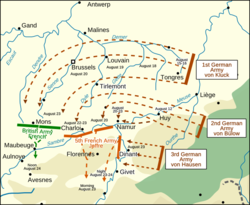
Back الغزو الألماني لبلجيكا Arabic Invasió alemanya de Bèlgica (1914) Catalan Německý vpád do Belgie (první světová válka) Czech Invasión alemana de Bélgica Spanish Bataille de Belgique (1914) French Dútske ynfal yn Belgje (1914) Frisian הפלישה הגרמנית לבלגיה HE Invasi Jerman ke Belgia (1914) ID Invasione tedesca del Belgio (1914) Italian 독일의 벨기에 침공 Korean
| German invasion of Belgium | |||||||||
|---|---|---|---|---|---|---|---|---|---|
| Part of the Western Front of the First World War | |||||||||
 German invasion of Belgium | |||||||||
| |||||||||
| Belligerents | |||||||||
|
Supported by: |
| ||||||||
| Commanders and leaders | |||||||||
|
|
| ||||||||
| Strength | |||||||||
| 750,000 men |
Belgium: 220,000 men France: 299,000 men UK: 247,400 men Total: 766,400 men | ||||||||
| Casualties and losses | |||||||||
| 20,000[citation needed] | 30,000[citation needed] | ||||||||
| 6,000 civilians killed in the Rape of Belgium | |||||||||
The German invasion of Belgium was a military campaign which began on 4 August 1914. On 24 July, the Belgian government had announced that if war came it would uphold its neutrality. The Belgian government mobilised its armed forces on 31 July and a state of heightened alert (Kriegsgefahr) was proclaimed in Germany. On 2 August, the German government sent an ultimatum to Belgium, demanding passage through the country and German forces invaded Luxembourg. Two days later, the Belgian government refused the German demands and the British government guaranteed military support to Belgium. The German government declared war on Belgium on 4 August; German troops crossed the border and began the Battle of Liège.
German military operations in Belgium were intended to bring the 1st, 2nd and 3rd Armies into positions in Belgium from which they could invade France, which, after the fall of Liège on 7 August, led to sieges of Belgian fortresses along the river Meuse at Namur and the surrender of the last forts (16–17 August). The government abandoned the capital, Brussels, on 17 August and after fighting on the Gete river, the Belgian field army withdrew westwards to the National Redoubt at Antwerp on 19 August. Brussels was occupied the following day and the siege of Namur began on 21 August.
After the Battle of Mons and the Battle of Charleroi, the bulk of the German armies marched south into France, leaving small forces to garrison Brussels and the Belgian railways. The III Reserve Corps advanced to the fortified zone around Antwerp and a division of the IV Reserve Corps took over in Brussels. The Belgian field army made several sorties from Antwerp in late August and September to harass German communications and to assist the French and the British Expeditionary Force (BEF), by keeping German troops in Belgium. German troop withdrawals to reinforce the main armies in France were postponed to repulse a Belgian sortie from 9 to 13 September and a German corps in transit was retained in Belgium for several days. Belgian resistance and German fear of francs-tireurs, led the Germans to implement a policy of terror (schrecklichkeit) against Belgian civilians soon after the invasion, in which massacres, executions, hostage-taking and the burning of towns and villages took place and became known as the Rape of Belgium.
After the Battle of the Frontiers ended, the French armies and the BEF began the Great Retreat into France (24 August – 28 September), the Belgian army and small detachments of French and British troops fought in Belgium against German cavalry and Jäger. On 27 August, a squadron of the Royal Naval Air Service (RNAS) flew to Ostend, to conduct air reconnaissance between Bruges, Ghent and Ypres. Royal Marines landed in France on 19–20 September and began scouting unoccupied Belgium in motor cars; an RNAS Armoured Car Section was created by fitting vehicles with bulletproof steel. On 2 October, the Marine Brigade of the Royal Naval Division was moved to Antwerp, followed by the rest of the division on 6 October. From 6 to 7 October, the 7th Division and the 3rd Cavalry Division landed at Zeebrugge and naval forces collected at Dover were formed into the Dover Patrol, to operate in the Channel and off the French–Belgian coast. Despite minor British reinforcement, the siege of Antwerp ended when its defensive ring of forts was destroyed by German super-heavy artillery. The city was abandoned on 9 October and Allied forces withdrew to West Flanders.
At the end of the Great Retreat, the Race to the Sea (17 September – 19 October) began, a period of reciprocal attempts by German and Franco-British forces to outflank each other, extending the front line northwards from the Aisne, into Picardy, Artois, and Flanders. Military operations in Belgium also moved westwards as the Belgian army withdrew from Antwerp to the area close to the border with France. The Belgian army fought the defensive Battle of the Yser (16–31 October) from Nieuwpoort (Nieuport) south to Diksmuide (Dixmude), as the German 4th Army attacked westwards and French, British, and some Belgian troops fought the First Battle of Ypres (19 October – 22 November) against the German 4th and 6th Armies. By November 1914, most of Belgium was under German occupation and Allied naval blockade. A German military administration was established on 26 August 1914, to rule through the pre-war Belgian administrative system, overseen by a small group of German officers and officials. Belgium was divided into administrative zones, the General Government of Brussels and its hinterland; a second zone, under the 4th Army, including Ghent and Antwerp and a third zone under the German Navy along the coastline. The German occupation lasted until late 1918.
© MMXXIII Rich X Search. We shall prevail. All rights reserved. Rich X Search